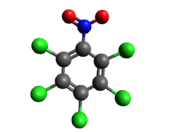Pentachloronitrobenzene
Pentachloronitrobenzene, typically abbreviated PCNB, is a registered fungicide formally derived from nitrobenzene. It is either an off-white or yellow solid, depending on its purity, with a musty odor.
.png) | |
 | |
| Names | |
|---|---|
| Preferred IUPAC name
1,2,3,4,5-Pentachloro-6-nitrobenzene | |
| Other names
Pentachloronitrobenzene PCNB Quintozene | |
| Identifiers | |
3D model (JSmol) |
|
| ChEBI | |
| ChEMBL | |
| ChemSpider | |
| ECHA InfoCard | 100.001.305 |
PubChem CID |
|
| UNII | |
CompTox Dashboard (EPA) |
|
| |
| |
| Properties | |
| C6Cl5NO2 | |
| Molar mass | 295.32 g·mol−1 |
| Appearance | Off-white or yellow crystals |
| Melting point | 144 °C (291 °F; 417 K) |
| Boiling point | 328 °C (622 °F; 601 K) decomposes |
| 0.44 mg/L | |
| Solubility | Slightly soluble in alcohols |
Except where otherwise noted, data are given for materials in their standard state (at 25 °C [77 °F], 100 kPa). | |
| Infobox references | |
Preparation
PCNB was originally synthesized in the laboratory in 1868. It was introduced to the agricultural world in the 1930s in Germany by Bayer AG as a substitute to mercurial pesticides. PCNB is prepared by chlorination of nitrobenzene at 60–70 °C in chlorosulfuric acid, with iodine as a catalyst. It can also be produced by the nitration of chlorinated benzenes. A side product of the synthesis of PCNB is hexachlorobenzene (HCB), which is considered as hazardous as PCNB.[1]
- 5 Cl2 + C2H5NO2 → C6Cl5NO2 + 5 HCl
Main reactions
Reaction with ethanol and potassium hydroxide yields pentachlorophenetole, indicating its high reactivity:[2]
- C6Cl5NO2 + KOCH2CH3 → C6Cl5OCH2CH3 + KNO2
Although PCNB has a long shelflife, it is labile in soil, with a half life of 1.8 days. It degrades to other metabolites, mainly reducing to pentachloroaniline (PCA), but also to pentachlorophenol (PCP) through hydrolysis and pentachlorothioanisole (PCTA). Another metabolite is methyl pentachlorophenyl sulfide (MPCPS). Little information is available about the degradation mechanisms.[3][4]
- C6Cl5NO2 + 6 [H] → C6Cl5NH2 + 2 H2O
- C6Cl5NO2 + 6 H2O → C6Cl5OH + HNO2
Applications
PCNB is used as a fungicide to suppress the growth of fungi in various crops, such as cotton, rice, and seed grains. It is also used to prevent the formation of slime in industrial waters. Residual amounts of the compound and its metabolites can be found in crops. The degradation products, PCA and PCTA have been found in farming soils and in river sediments.[5]
In April 1993, PCNB was declared a hazardous air pollutant in the U.S.[6] PCNB was reexamined for re-registration eligibility by the U.S. EPA in 2006 as part of the 1996 Food Protection Quality Act (FPQA) and as a result, use on a number of crops were ended or limited. In August 2010, in response to the discovery of a potentially toxic metabolite in technical grade PCNB to be used in fungicide formulations, the sale of PCNB was halted by the U.S. EPA until the issue could be resolved.[7] In November 2011, the EPA approved certain registrations for PCNB, allowing it back on the market for golf course turf, potato, cotton, ornamental bulb and cole crop uses in the United States.[8] PCNB is used widely as a fungicide in other countries, such as China and Japan.[5]
References
- Cairns, Thomas; Siegmund, Emil G.; Krick, Fred (1987). "Identification of several new metabolites from pentachloronitrobenzene by gas chromatography/Mass spectrometry". Journal of Agricultural and Food Chemistry. 35 (3): 433–439. doi:10.1021/jf00075a037.
- Booth, G. (2000). Nitro Compounds, Aromatic. Ullmann's Encyclopedia of Industrial Chemistry (electronic release 7th ed.). Weinheim: Wiley-VCH. ISBN 9783527306732.
- Sung-Kyu Shin; et al. (2003). "Isolation and Identification of a Pentachloronitrobenzene (PCNB) Degrading bacterium Alcaligenes xylosoxidans PCNB-2 from Agricultural Soil". The Journal of Microbiology: 165–168.
- Tonghua Sun; et al. (2006). "Determination of 17 kinds of Banned Organochlorine Pestides in Water by Activated Carbon Fiber-Solid Phase Microextraction Coupled with GC-MS". Anal. Sci. 22 (2): 293–8. doi:10.2116/analsci.22.293. PMID 16512425.
- Sullivan, J. B.; Krieger, G. R. (2001). Clinical Environmental Health and Toxic Exposures (2nd ed.). Philadelphia, PA: Lippincott Williams & Wilkins. pp. 1111–1112. ISBN 978-0-683-08027-8.
- Howard, P. H. Handbook of Environmental Fate and Exposure Data for Organic Chemicals: Pesticides , CRC Press, 1991; pp. 551-553. ISBN 0-87371-328-1, ISBN 978-0-87371-328-3
- "Reregistration Eligibility Decision for Pentachloronitrobenzene" (PDF). Environmental Protection Agency.
- "PCNB back on the market for golf course turf". GCSAA News. Golf Course Superintendents Association of America. 28 Nov 2011. Retrieved 2013-05-28.
Bibliography
- Aschbacher PW, Feil VJ, Metabolism of pentachloronitrobenzene by goats and sheep; J Agric Food Chem. 1983 Nov-Dec; 31(6):1150-8.